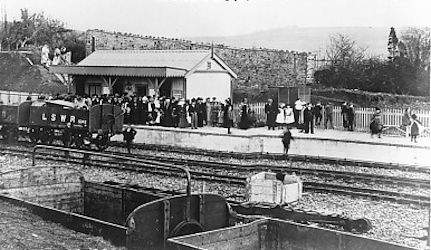|
OLD DEVONPORT
. UK |
||
|
© Brian
Moseley, Plymouth Webpage created: April 07, 2019 Webpage updated: May 10, 2021 |
||
|
RAILWAYS IN OLD DEVONPORT
|
CALLINGTON BRANCH BERE ALSTON AND CALSTOCK LIGHT RAILWAY
Passengers awaiting their first railway travel
experience at Calstock Station Following the opening by the Plymouth, Devonport and South Western Junction Railway Company of their new main line between Lydford Station and Devonport Station in 1890, they purchased the East Mineral Railway Company the following year with a view to extending it to link up with their main line. They obtained the Bere Alston and Calstock Light Railway Act and extended the line from Calstock Station over the Calstock Viaduct and up a steep incline to Bere Alston Station. In addition they changed track to standard-gauge (4 feet 8½ inches) and upgraded it to enable passenger trains to be run. Although the main line was taken over by the London and South Western Railway Company, the Bere Alston and Calstock Light Railway was retained by the Plymouth, Devonport and South Western Junction Railway Company and worked by their own locomotives and rolling stock. The official opening took place on Monday March 2nd 1908. The first train left Bere Alston Station at 8.35am and was fairly well patronised. However, the official opening train left Bere Alston Station at Midday and was drawn by the Company's locomotive "A Saunders Harris". Enthusiastic crowds gathered at Calstock Station, Gunnislake Station, Latchley Station and Stokeclimsland Station (sic). In Callington the two schools were granted a half-holiday so that the pupils could be gathered together in the market place at Noon and, headed by the Callington Brass Band, marched to Kelly Bray to watch the arrival of the official train. Not surprisingly they were each given a bun by Mr J Venning and they later enjoyed various sports in the Waterloo Recreation Ground. A public luncheon was held in the newly-erected Public Rooms at Kelly Bray, which just happened to be owned by the said Mr Venning, and during the afternoon tea was served there, too. Mr J Chubb, of Callington, was responsible for the catering. The Correspondent of "The Cornish and Devon Post" reported: 'The powerful engines of the company, and smart commodious coaches, were the centre of much attention and admiration, and throughout the day a stream of moving life poured into the new station. Every train was crowded with passengers. The agility of the officials, combined with their obliging manner, courted the laudatory applause of the surging, but orderly crowds.' There were five trains a day in each direction, although one only ran to and from Gunnislake. The first train left Callington Road Station at 7.23am and called at Stokeclimsland at 7.32am, Latchley at 7.39am, Gunnislake at 7.51am, Calstock at 8.08am and was due to arrive at Bere Alston Station at 8.15am, in time to catch trains to both London Waterloo and Plymouth's Friary Station. The return train left Bere Alston Station at 8.33am, after connecting with trains from Friary Station and Tavistock Station, and called at Calstock, 8.40am, Gunnislake, 8.55am, Latchley, 9.08am, Stokeclimsland, 9.16am and was due to arrive at Callington Road Station at 9.25am. At 9.50am the train once again left Callington Road Station for Stokeclimsland, 9.57am, Latchley, 10.03am, Gunnislake, 10.13am, Calstock, 10.28am, and was due to arrive at Bere Alston Station at 10.35am, where it connected only with a train for Friary Station. After connecting with the 11.03am from Friary Station, it left Bere Alston at Midday for Calstock, 12.07pm, Gunnislake, 12.21pm, Latchley, 12.31pm, Stokeclimsland, 12.37pm and Callington Road, 12.45pm. The afternoon service commenced at 1.40pm from Callington Road and 1.47pm from Stokeclimsland. Oddly this service did not stop at Latchley but went on to Gunnislake Station, 2pm, Calstock, 2.13pm and Bere Alston at 2.29pm. The Up connecting train would get passengers in to London Waterloo Station at 8.07pm or in to Friary Station at 3.14pm. That train returned at 2.55pm from Bere Alston Station, calling at Calstock, 3.02pm, Gunnislake, 3.16pm, Stokeclimsland, (after missing out Latchley) 3.30pm and and got to Callington Road at 3.38pm. At 4.55pm the last Up train of the day left Callington Road Station. It left Stokeclimsland at 5.02pm, Latchley at 5.08pm, Gunnislake at 5.17pm, Calstock at 5.30pm and was due at Bere Alston at 5.37pm. It connected with trains for Tavistock and Friary only. The 4.57pm from Friary Station, 5.15pm from Devonport Station, connected at Bere Alston with the 6.05pm which called only at Calstock at 6.12pm and Gunnislake at 6.26pm. This short working was back at Bere Alston at 7pm for the last Down train of the day at 7.40pm. This not only connected with a train from Plymouth but also the 1pm from London Waterloo. The last train called at Calstock at 7.47pm, Gunnislake, 8.01pm, Latchley, 8.11pm, Stokeclimsland, 8.17pm and was due to arrive at Callington Road Station at 8.25pm. The Bere Alston and Calstock Light Railway, as part of the Plymouth, Devonport and South Western Junction Railway, remained independent until it was absorbed in to the Southern Railway Company in 1923.
|
||
